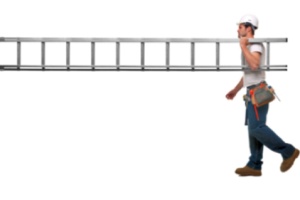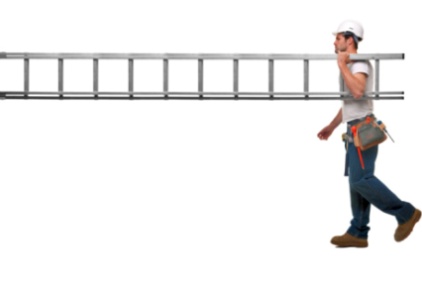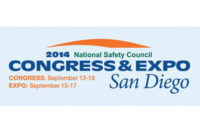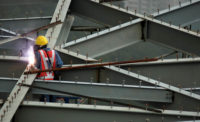 Topic: Firefighters
Topic: Firefighters
Q) Has your company ever worked with firefighters to address their specific fall protection needs while performing their daily work duties? How so?
A) No, however leading firefighters are aware of the Fall Protection Code and are presently practicing under the NFPA 1983 Standard on Life Safety Rope and Equipment for Emergency Services. One big difference with hardware is the use of screw-lock carabiners prohibited by OSHA and ANSI Z359. There needs to be resolution between the Z359.4 and the NFPA 1983 to allow outside rescue groups to work within the framework of a safety plan for emergency response required by OSHA for prompt rescue.
Topic: Ladders
Q) Is there a hazard using ladders?
A) Most ladder applications have a hazard of falling that cannot be denied. A ladder is a method of access from one level to another.
Suppose the ladder is at 200-250 feet on the outside of a scaffold for the replacement of a flare tip at a refinery and accessed by suspended work platform because the fixed ladder is corroded. Do we ignore the hazard or do we in the pre-planning stage agree to put the access inside the scaffold in the form of ladders or stairs and break the climb so fall distance is reduced? Suppose we eliminate the use of ladders altogether? We did this at an industrial bakery in North Carolina in 1990. The subcontractors howled. So we gave them a bone and limited ladder access to ten feet standing height above which aerial lifts or a scaffold was required. BLS statistics showed that a fatality rate at 6 ft is 1% of fall deaths and 10 ft is 10% of the total.
The hierarchy of controls for access should begin with elimination of the need for access just like fall protection, so we substitute or reschedule. Next is stairs with handrail training and scaffolds or aerial lifts depending on application. Since ladder falls are the most dangerous of fatality causes we need to limit their use. The new hierarchy of fall protection referenced in Dave MacCollum's Construction Safety Engineering Principles includes additional safety factor and redundancy (Introduction to Fall Protection 4th edition, May 2011). So portable ladders can move to 1AAA for stability and stepladders facing the work can be held by a partner if we reach back to ladders. Fixed ladders are beginning to have some options of simple elevating work platforms (ref SIA Exhibit Philadelphia 7 21 10.) The sloped ship's ladder has some benefits including in-built railings that must be held. In fact maybe we should angle fixed ladders to gain some support for an otherwise vertical fall like is being considered in Australia.
Preplanning allows us to consider these options so we are not trapped by traditional views and by the 29CFR1926. Ladders will certainly be around for decades to come but homeowners may become the main market and can be helped by the withdrawal of Type III ladders.
Topic: Skylights
Q) I'm interested in understanding the number of falls, injuries, and deaths each year related to overhead glazing/skylights, looking at both the residential and the commercial market segments.
A) The Bureau of Labor Statistics (BLS) is the way to find occupational reported deaths. There were 666 occupational fatalities due to falls, slips and trips in 2011, or about 14 percent of all fatal work injuries. Falls to lower level accounted for 541 of those fatalities.Severe injury can be 300 times this number. (see National Safety Council Injury Facts ratio of death to injury).
Of course, these statistics assume there must be a responsible employer or owner available to report deaths to OSHA and more than one employee in a firm.
The number of skylight deaths is reported fairly stable at 23 falls through skylights for the past several years in BLS annual fatality data. (20-35 from 2004-2010).
The NIOSH FACE reports give some good detail on fatalities in occupational settings; check the 2000 publication of NIOSH “Fatal Falls”. Individual FACE reports are available from NIOSH and each reporting state.
The two NIOSH Hazard Alerts on skylights show mostly plastic bubble and corrugated fiberglass fall-throughs. Only 1% skylights have structural railings or screens but new products can be placed over unit skylights and should be secured to avoid casual removal by contractors (eg www.garlock.com)
Residential skylight failures should be available through NEISS reports and CPSC records. Steeper skylights are typically glass and present fewer hazards
The lack of durability of skylights in general is one reason that OSHA 1926.500-503 construction regs refer to skylights as "open holes". The draft standard ASTM E06.51.25 requires a drop of 300 lbs through three feet less curb height. Three tests are center, side and corner which more skylight manufacturers are subjecting their skylights to (eg www.vtech.com). Two lenses (eg aliphatic urethanes and polycarbonate) seem able to pass accelerated weathering tests for labeling to 20 years.
About Nigel Ellis, Ellis Fall Safety Solutions / Wilmington, DE
A leading authority on fall protection hierarchies, Dr. Ellis conducts consultations, investigation and high level education in fall protection from management's, workers' and regulatory perspectives.
- Frequently provides input for the OSHA standards and interpretations that apply to his field since 1971.
- Represents the USA on international standards committees
- Is a long-standing member of several ANSI standards committees, including former chair of the ANSI Z359.2 Committee and current co-chair of ASTM EO6.51.25 WG Skylight Human Impact
- Serves as an expert witness in negligence, intentional tort, peculiar risk, product civil cases, OSHA, and other court cases for both plaintiffs and defendants
- Started and became lead presenter for the OSHA Training Institute's Fall Protection Training program for many years
- Dr. Ellis is a Board-Certified Safety Professional (in three specialties), a Registered Professional Safety Engineer and a Board-Certified Human Factors Professional
- Dr Ellis has personally trained more than 20,000 managers and workers in fall protection techniques and procedures since 1970. The FallSafety.com website is the source on archived questions, answers covering many topics relating to fall protection.
- Dr. Ellis was awarded the Distinguished Service to Safety Award (DSSA) by the National Safety Council, 2007. He was also recognized with the #109 Fellow Honor Award of the American Society of Safety Engineers 2010. Also, he has been recognized in 2011 with the Thomas Bresnahan Standards Medal for voluntary standards involvement in standards. Dr Ellis is currently president of the Veterans of Safety.


